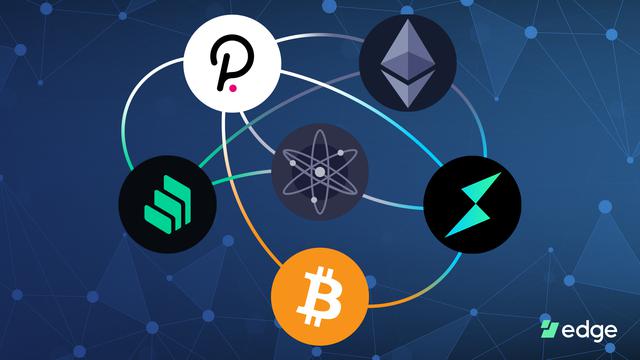Ethereum is one of the top cryptocurrencies, just behind Bitcoin in terms of market cap and overall popularity. Despite the recent bear market, it has kept itself relatively stable compared to altcoins. The ETH roadmap of the next few years is particularly exciting and promises to be a paradigm shift in the way we conceptualize cryptocurrency.
“The Merge,” or as it was known before, ETH 2.0, will transform Ethereum to a Proof of Stake (PoS) consensus mechanism from a Proof of Work (PoW) consensus mechanism. The energy-intensive mining that currently exists under PoW will be replaced by a sustainable staking system under which ETH holders can stake their tokens to become a validator and ensure the blockchain’s security, while earning rewards for themselves.
Multi-chain is a concept. It refers to a system or general state of the crypto sector that allows for more than one blockchain to exist at the same time. At a basic level, it works with the concept of bridging, where a bridge connects two different chains at a time. When transferring assets from one chain to another, the asset is minted on the target chain, and the wrapped version on the old chain is burnt. The reverse occurs when the asset is released to the original chain — a process known as “redeeming.”
One of the most exciting features of multi-chain technology is the ability to build chains that can process transactions faster and more cheaply than the mainstream chain. This opens the door for many different use cases, including new currencies, side chains and other innovations. This enables the creation of more complex smart contracts, which in turn provides the ability to build more advanced decentralized applications (dapps).
The best way to imagine a multi-chain network is to view it as a blockchain network that is made up of multiple chains. These chains can be thought of as individual blockchains that are linked together using a shared blockchain history.
Related: Inside Ethereum's Internet Of Blockchains
How multi-chain interacts with Ethereum
The biggest hurdles faced over the widespread adoption of crypto are congestion during high volumes and challenges faced in scalability. These challenges lead to longer transaction processing times and higher transaction fees, causing frustration and decreasing the likelihood of crypto being adopted for day-to-day use. Ethereum, in particular, faces these issues a lot, with wait times varying from five minutes to occasionally over three to four hours.

Multi-chain aims to eliminate these issues by enabling you to engage in a cross-chain ecosystem, increasing overall efficiency and decreasing wait times. As it is right now, the DeFi ecosystem lacks flexibility, prohibiting transactions between different chains and effectively reducing the number of serious competitors to a few major chains due to large gas fees and wait times. Within a multi-chain ecosystem, not only do costs and wait times go down, there’s an increase in the rate of innovation since developers can access one another’s systems and learn, reducing complexity and increasing cooperation.
Ethereum is planning a major change in its architecture, known as The Merge. Moving to a PoS model eliminates many of the problems currently faced by it since lower fees and quicker transactions are to be expected from a less computation-heavy model when compared to PoW.
The Merge upgrade is estimated to launch in the second quarter of 2022, which just might be the thing to end the current bear market, at least for ETH and cryptos based on the ETH chain. One can already transfer tokens via L2 rollups on Ethereum, and the rollups increase the TPS (transactions per second) of the chain to a respectable 2000-4000 TPS. Even Visa, one of the biggest payment methods, only handles 1700 TPS.
Related: Explore the Modern World of Cryptocurrency
What the future holds
With the current and planned improvements on the Ethereum blockchain, multi-chain might be rendered redundant, and Ethereum will become the dominant chain in terms of transaction volume. But again, it might not necessarily be the death blow for multi-chain. Instead, the two could take on a symbiotic relationship. As Ethereum increases its efficiency, working in tandem with multi-chain could bring down the wait times even more.
Multiple blockchains, like BSC, Solana and L2 chains like Polygon, are being worked on, and each of them have unique advantages and disadvantages. These advantages and disadvantages facilitate the growth of multi-chain and tell us that a diverse array of options are better than one blockchain dominating the market, especially as non-currency projects like ID verification, NFTs, etc., have begun popping up, utilizing the blockchain in various ways.
With the multi-chain, competition takes a backseat, and cooperation to deliver the best quality possible becomes a priority, ultimately improving the user experience. It can be compared to the early days of the internet when individual networks existed for universities and offices, and a common internet was in its infancy. With time, every technology undergoes improvements and matures until its ubiquitous, and the blockchain is no different.
Related: Learn How to Build Your Own Projects on the Ethereum Blockchain
To capitalize on the recent trend towards DeFi, a stable and secure infrastructure is sorely needed. Ethereum working alongside multi-chain will eliminate some of the biggest problems prevalent in the blockchain ecosystem, paving the way for widespread adoption and a decentralized economic future.




